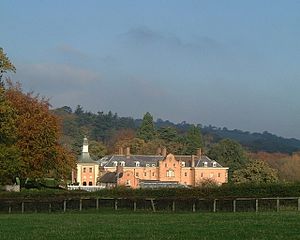Nantclwyd Hall facts for kids
Nantclwyd Hall is a beautiful old mansion in Denbighshire, Wales. It was built in the 1600s. This grand house is near the village of Llanelidan. It is a very important building, listed as Grade II*. The Parry family first built it. Later, Eubule Thelwall and his wife Mary Parry rebuilt parts of it. Mary was the owner of the land.
Contents
History of Nantclwyd Hall
Early Owners: The Parry Family
The story of Nantclwyd Hall begins in 1571. A man named Thomas Wynn ap John ap Harry bought land in Llanelidan. He had two sons, Simon and Gabriel. Simon helped make the family's properties bigger. Gabriel became the headmaster of Ruthin School.
The first buildings at Nantclwyd Hall were put up in the 1600s. Simon Parry, who was a lawyer, bought more land in 1603. This is when the name "Nantclwyd" first appeared in records. It means "the brook over the river Clwyd." This name likely referred to the area, not just the house. The original house was called "Pont-y-gof." It was probably where Nantclwyd Hall stands today. Simon Parry was also the first in his family to use a surname, "Parry," like English families did.
Simon married Jane Thelwall. In 1620, their home was called "Plas yn Pont y Go." When Simon died in 1627, his son William took over the house. William also became a lawyer. He had only one daughter, Mary. When William died, Mary inherited a large estate. It included over a thousand acres of land.
The Thelwall Family Takes Over
In 1653, Mary Parry married Eubule Thelwall. The Thelwalls were another family of lawyers. Eubule's great-uncle, Sir Eubule Thelwall, was an important person. He was the head of Jesus College, Oxford.
Eubule Thelwall (Mary's husband) was involved in history too. He served during the siege of Denbigh Castle. He even carried a message to King Charles I. Eubule and Mary lived at Nantclwyd from 1662. Eubule bought more land for the estate. He also loved gardening. You can see this from his letters to Sir Walter Bagot. Eubule and Mary had eleven children.
Later, their son, also named Eubule, took over. He was also a lawyer. He was very strict. Records show that in 1701, he ordered police to stop people from playing games on Sundays. He married Susan Puleston. When he died in 1713, the main Thelwall family line at Nantclwyd ended. His daughter, Martha, inherited the estate. She married Thomas Puleston in 1718.
Nantclwyd Hall in Recent Centuries
In the 1800s, Nantclwyd Hall became the home of the Naylor-Leyland baronets. These were important families with special titles. Herbert Naylor-Leyland lived there, then his son Albert Naylor-Leyland, 2nd Baronet.
A very interesting event happened at the estate in 1873. Major Walter Clopton Wingfield introduced his friends to a new game. He called it "Sphairistike." This game was the start of modern lawn tennis as we know it today! The rules for tennis were created right there at Nantclwyd Hall.
Later, Sir Vivyan Edward Naylor-Leyland lived at the hall. He made many changes to the house. He hired a famous architect, Clough Williams-Ellis. They made the main house smaller. They also added new gardens, gates, and even a special temple. They built stables with a clock tower and a bridge over the river.
Today, Nantclwyd Hall is the home of Sir Philip Vyvyan Naylor-Leyland. He has also added new features, like a special grotto.
Architecture and Design
Nantclwyd Hall is a very important building. It has been listed as Grade II* since 1966. This means it is a building of special interest. Many other parts of the estate are also listed as Grade II. This shows their historical importance.
Some of these special features include:
- An archway with a clock tower at the entrance.
- A bridge on the main driveway.
- A unique shooting hide shaped like a castle.
- Gateways around the property.
- A round building by the lake.
- The main entrance gate to the hall.
- An office building near the hall.
- A sculpture of a stag and hounds at the entrance.
- A walled garden with special small buildings called gazebos.
- The old main gates on the west side.
- A small house at the west entrance.


